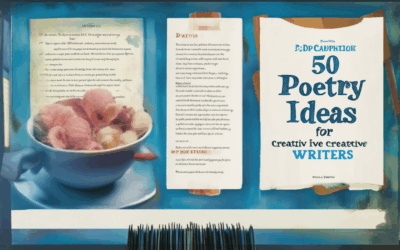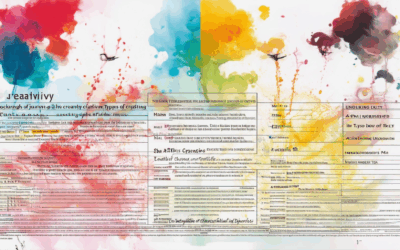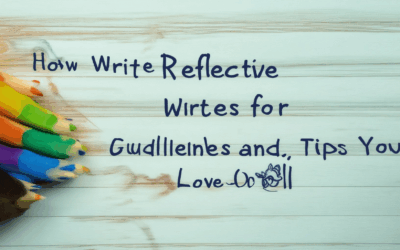Unlocking your creativity as a writer can be a transformative experience, and the right exercises are powerful tools to help you achieve this. Whether you’re a seasoned writer looking to break creative blocks or someone just beginning their journey, effective writing exercises can unlock new dimensions of expression and innovation. From daily habits to experimental genres, from goal-setting to routine-building, there are countless strategies to nurture your creative potential. These exercises aren’t just for professionals—they’re accessible to anyone willing to put pen to paper or fingers to keyboard. By exploring mind mapping, stream-of-consciousness writing, character development, and plot twists, you can discover fresh perspectives and elevate your storytelling. Whether you’re teaching others or embarking on your own creative journey, these practices offer a wealth of opportunities to grow as a writer and thinker. Join us as we delve into the world of creative writing exercises, tools that can inspire and transform your approach to writing forever.
Key Takeaways
- Unlock Creativity with Tailored Writing Exercises: Discover curated exercises to enhance adult writing skills, fostering imagination and storytelling prowess.
- Develop Compelling Characters: Through sketches, profiles, and dialogues, craft relatable and dynamic characters.
- Craft Immersive Settings: Design fictional worlds with rich sensory details and cultural authenticity.
- Structure Engaging Narratives: Master story arcs, conflicts, and twists to create compelling plots.
- Enhance Dialogue Depth: Use conversational, situational, and dialect-rich interactions to add dimension to your characters.
- Vivid Descriptions Drive Impact: Employ sensory details, metaphors, and visual imagery to paint evocative scenes.
- Inspire with Thoughtful Prompts: Explore prompts that challenge creativity and encourage meaningful reflection.
- Effective Strategies for Teaching Writing: Foster collaboration, incorporate technology, and leverage great literature to inspire learning.
- Self-Teaching Made Possible: Through dedicated practice, wide reading, and community support, anyone can refine their writing skills.

How Can I Practice Writing Creatively?
To enhance your creative writing skills, consider incorporating the following structured approach:
- Freewriting : Begin by dedicating 10 minutes daily to freewriting. This technique allows your thoughts to flow naturally without interruption, helping overcome writer’s block and fostering creativity.
- Mind Mapping : Create visual diagrams to organize ideas. This method aids in exploring characters, settings, and plotlines, providing a clearer structure for your narratives.
- Writing Prompts : Utilize prompts to spark inspiration. These can be found in various resources, including online platforms and books, encouraging you to explore diverse themes and perspectives.
- Revision and Editing : After completing a piece, revisit it to refine details. Reading aloud or seeking a second opinion can help identify areas for improvement, enhancing overall quality.
- Seek Feedback : Share your work with trusted friends, family, or online communities like Silken Drum to receive constructive criticism and gain new insights.
- Read Widely : Engage with various literary works across different genres to study styles and storytelling techniques, broadening your creative horizons.
- Watch and Learn : Observe how dialogue and pacing are handled in films and TV shows to apply these elements effectively in your own writing.
- Daily Practice : Establish a routine, even if brief, to maintain consistency. Setting achievable goals, such as writing 300 words daily, can help sustain this habit.
- Explore Tools : Consider using apps or software for grammar checking, outlining, or drafting to streamline your process and enhance efficiency.
- Join Communities : Participate in online platforms like Silken Drum to connect with fellow writers, gain motivation, and access valuable resources.
By systematically applying these strategies, you can develop your creative writing abilities over time, embracing the journey towards growth and self-expression.
What is the Best Practice for Creative Writing?
Understanding Yourself and Your Medium
- Creative writing begins with understanding yourself and your medium. Whether it’s poetry, prose, or another form, consistency and authenticity are key. Experiment with different styles to discover what resonates most with you and your audience.
- Reflect on personal experiences, emotions, and observations to infuse your writing with genuine feeling. This authenticity helps connect readers on a deeper level.
- Research your chosen genre and successful authors within it to understand common techniques and conventions. This knowledge can guide your approach while allowing room for personal innovation.
Developing Unique Characters
- Create well-rounded, relatable characters who undergo meaningful growth or reveal hidden depths. Readers connect with characters who feel real and multifaceted.
- Give characters distinct traits, backgrounds, and motivations. This adds depth and keeps the narrative engaging.
- Show, don’t tell. Use actions, dialogue, and descriptions to reveal character traits and emotions rather than stating them directly.
Setting the Scene Effectively
- A strong setting enhances the story by providing atmosphere and context. Whether it’s a historical epoch, futuristic city, or intimate living room, the setting should feel immersive.
- Use descriptive language to paint vivid pictures. Engage the senses through sight, sound, smell, taste, and touch to immerse the reader.
- Consider how the setting influences the plot and characters. Is it a constraint, a catalyst, or simply a backdrop?
Crafting a Compelling Plot
- Structure your story with a clear beginning, middle, and end. A strong hook grabs attention early, while a satisfying resolution leaves a lasting impact.
- Build tension and conflict to drive the narrative forward. Whether it’s internal struggle or external challenges, keep the reader invested.
- Plan ahead to ensure your plot developments are logical and cohesive. Anticipate twists and turns that surprise while staying true to your theme.
Editing and Revising
- Edit your work to remove redundancies, clarify pacing, and enhance clarity. Eliminate unnecessary words and streamline your sentences for maximum impact.
- Revise for consistency in tone, style, and point of view. Ensure the narrative remains coherent and aligned with your vision.
- Seek feedback from trusted peers or mentors to gain fresh perspectives and identify areas for improvement.
Reading and Learning
- Read widely to inspire your own writing. Study classic works, contemporary literature, and genres outside your comfort zone.
- Analyze successful authors to learn their techniques, structural choices, and stylistic approaches.
- Engage in writing exercises and workshops to sharpen your skills and stay motivated.
Building a Community
- Join writing communities to share your work, receive feedback, and find inspiration. Platforms like Writer’s Digest and National Poetry Society offer valuable resources and connections.
- Participate in writing challenges and contests to push your boundaries and gain recognition.
- Collaborate with other writers to exchange ideas and create cross-promotional opportunities.
By following these principles, you can develop your unique voice and continuously grow as a writer. Remember, creativity is a journey, and every great piece starts with a spark of inspiration. Explore, experiment, and never stop learning.

Best Writing Exercises
Writing is a skill that can be honed through targeted exercises. Here are some effective techniques to improve your writing:
- Free Writing:** Set a timer for 15 minutes and write continuously without stopping. This helps overcome writer’s block and builds momentum.
- Stream of Consciousness:** Write down your thoughts as they come without filtering them. This technique helps tap into your subconscious mind.
- Journaling:** Keep a daily journal to document your thoughts, feelings, and experiences. This fosters self-awareness and improves descriptive skills.
- Describe What You See:** Close your eyes and vividly describe the scene in your mind. This enhances sensory detail in your writing.
- Write a Letter:** Compose a letter to someone, whether real or imaginary. This exercise improves emotional connection and narrative skills.
- Reverse Writing:** Start with the end of a story and work backward to develop a plot. This challenges your creativity and problem-solving abilities.
- Use All Senses:** Incorporate visual, auditory, tactile, and olfactory details to make your writing more immersive.
- Write a Dialogue:** Create a conversation between two characters. This sharpens your ability to convey meaning through speech.
- Eliminate Fluff:** Write a paragraph and then remove 50% of the words. This helps focus on essential elements and economy of language.
- Write About Failure:** Reflect on a past failure and explore its impact. This deepens your understanding of human resilience and complexity.
These exercises can be found and explored further on our platform, where you can discover more resources to enhance your writing journey. Join us today and take your writing to the next level!

Are There Any Creative Writing Exercises for Adults?
Yes, there are numerous creative writing exercises tailored for adults to foster imagination and refine storytelling skills. Here’s a curated list of effective exercises, organized by category for ease of navigation:
Character Development
- Character Sketch: Dedicate 15 minutes daily to sketching characters. Focus on physical traits, personality quirks, and background stories.
- Personality Profile: Create a detailed profile using adjectives, hobbies, and motivations. Share with a writing group for feedback.
- Dialogue Practice: Write conversations between two contrasting characters. Aim to reveal their personalities through their interactions.
Setting and World-Building
- Imaginary Locale: Design a fictional town, planet, or historical era. Describe sensory details to bring the setting to life.
- Scene Setup: Craft a vivid scene using five senses. Consider elements like weather, sounds, and smells to immerse the reader.
- Cultural Context: Research a culture and infuse it into your writing. Explore traditions, dialects, and customs to add authenticity.
Plot and Story Structure
- Story Arc Outline: Develop a story arc with a clear beginning, middle, and end. Include a central conflict and resolution.
- Conflict Creation: Brainstorm conflicts that drive your protagonist. Consider internal and external challenges.
- Plot Twists: Introduce unexpected turns. Think about how these twists could impact your characters and plot.
Dialogue Writing
- Conversational Writing: Write a conversation between two characters. Ensure their dialogue reflects their personalities and relationship.
- Situational Dialogue: Create realistic dialogue in specific scenarios, such as a job interview or a first date.
- Dialect Exploration: Experiment with different accents and speech patterns to add depth to your characters.
Descriptive Writing
- Sensory Description: Use all five senses to describe a scene. Focus on what characters see, hear, smell, taste, and touch.
- Metaphorical Language: Incorporate metaphors and similes to enhance descriptions. Make the imagined world more tangible.
- Visual Imagery: Paint pictures with words. Focus on details that evoke strong visual reactions.
Creative Writing Prompts
- Prompt 1: Write a letter from a historical figure to a contemporary issue. Reflect on their perspective and emotions.
- Prompt 2: Create a world where technology has evolved beyond human control. Explore the consequences of this shift.
- Prompt 3: Write about a moment of realization or epiphany. Capture the internal struggle and eventual acceptance.
These exercises can be found and explored further on our Creative Writing Resources page, where you’ll find additional tips, guides, and inspiration to fuel your creativity.
How to Teach Creative Writing in a Fun Way
Teaching creative writing can be an exciting and rewarding experience. Here are some effective strategies to make the process engaging and enjoyable for both teachers and students:
- 1. Create a Collaborative Environment
- Start by establishing a supportive and inclusive classroom atmosphere where students feel comfortable expressing themselves.
- Organize group activities or workshops where students can share ideas and inspire each other.
- 2. Utilize Creative Prompts
- Provide a variety of creative writing prompts to spark imagination and curiosity.
- Encourage students to experiment with different genres and styles to broaden their horizons.
- 3. Incorporate Gamification
- Introduce writing challenges or competitions to add an element of fun and competition.
- Use platforms like Silken Drum to showcase student work and track progress.
- 4. Leverage Technology
- Use online tools and apps to enhance the learning experience. For example, tools like Grammarly can assist with editing and proofreading.
- Explore mind-mapping software to visually organize story ideas and structures.
- 5. Read and Analyze Great Works
- Expose students to influential works of literature and analyze them to understand different writing styles and techniques.
- Assign writing assignments inspired by these works to encourage creative application.
- 6. Use Visual Aids
- Illustrate complex writing concepts with diagrams or visuals to make abstract ideas more tangible.
- For example, use charts to demonstrate character development or plot structure.
- 7. Foster Feedback and Growth
- Establish a culture of constructive feedback where students can learn from each other’s strengths and areas for improvement.
- Implement a peer review system to encourage mutual support and learning.
- 8. Make It Personal and Experimental
- Allow students to write about topics they’re passionate about to increase engagement and motivation.
- Encourage experimentation with different writing styles and genres to help students discover their unique voice.

Can Creative Writing Be Self-Taught?
Yes, creative writing can absolutely be self-taught. With dedication, curiosity, and a willingness to learn, anyone can develop their skills in crafting compelling narratives, poetry, or other forms of creative expression. The key lies in consistent practice, analysis of successful works, and a commitment to refining your craft.
One of the most effective ways to teach yourself creative writing is by studying great works of literature and analyzing their structure, themes, and techniques. By breaking down successful pieces, you can identify patterns and apply those principles to your own writing. Here’s how you can begin:
- Start Small : Begin with simple exercises, such as writing a short poem or a descriptive paragraph. Gradually increase the complexity of your projects as your confidence grows.
- Join Writing Communities : Engage with other writers who share your passion. Platforms like Silken Drum offer opportunities to connect with fellow creatives, participate in workshops, and receive feedback on your work.
- Read Widely and Deeply : Immerse yourself in various genres and styles. Read books, poems, scripts, and articles to understand the diversity of creative expression and draw inspiration from different sources.
- Experiment and Iterate : Don’t hesitate to try different approaches. Write in different voices, explore unique perspectives, and be open to revising your work based on feedback or personal growth.
- Set Goals : Establish measurable objectives, such as completing a novel, submitting a portfolio, or participating in a writing contest. These goals will keep you motivated and focused.
- Seek Resources : Utilize online courses, tutorials, and guides to enhance your skills. Websites like Silken Drum provide valuable resources and tools to support your learning journey.
Remember, creative writing is a personal journey. There’s no one-size-fits-all approach, and it’s okay to evolve your style over time. With persistence and patience, you’ll continue to grow as a writer.




0 Comments